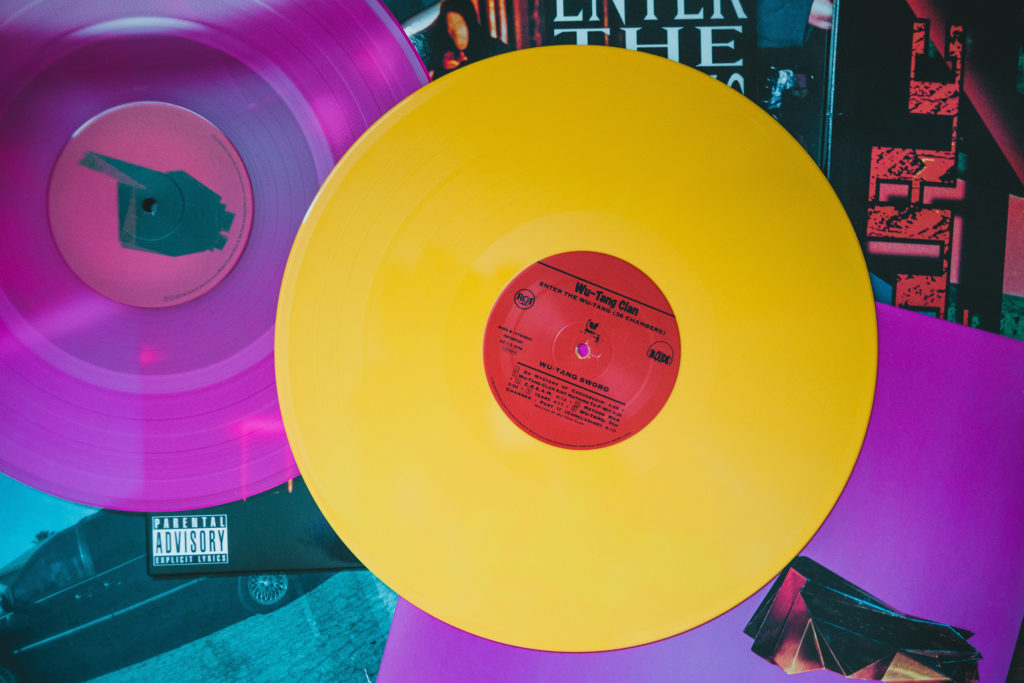Making an album is a monumental achievement for any musician. While singles and EPs serve their purpose, releasing a full-length album makes a definitive statement about who you are as an artist. An album allows you to share your in-depth perspectives through 10-15 songs that complement each other. It provides the canvas to paint a complete musical picture. That’s why so many artists consider releasing an album the pinnacle of their careers.

How to Make an Album: Table of Contents
The album format has a rich history and nostalgia in music culture. Iconic albums like The Beatles’ Sgt. Pepper’s Lonely Hearts Club Band, Pink Floyd’s The Dark Side of the Moon, and Lauryn Hill’s The Miseducation of Lauryn Hill have become etched in the public consciousness. Even in today’s singles-driven streaming landscape, albums retain their importance. Fans eagerly await new album releases from their favorite musicians. Critics assess an artist’s growth and maturity from one album to the next. For any developing artist, to make an album signals your arrival as a serious, committed musician.
But producing an album requires extensive planning, dedication, and work. You need to select the right songs, assemble a production team, rent studio space, and meticulously record the tracks. Mixing and mastering require their own specialized skills to get the sound just right. And don’t forget the business aspects like budgeting, promotion, and distribution.
The entire process can seem daunting, especially for first-time album creators. But breaking it down into clear steps makes it feel more achievable. This guide will walk you through the key phases of how to make an album, from initial brainstorming to holding the finished product in your hands. We’ll also provide tips to avoid common pitfalls. So take a deep breath, summon your inspiration, and get ready to join the ranks of storied album makers. The sensation when fans finally get to hear your unique musical vision will make all the effort worthwhile.

Before You Start Recording
Before you even enter the recording studio, some of the most vital work happens in the planning stage. This phase lays the creative foundation for your entire album.
Choosing the Concept and Songs
Coming up with an album concept can feel overwhelming at first. But start by brainstorming ideas that genuinely excite you as an artist. Think about the messages you want to get across, stories you want to tell, or musical styles you want to explore. Discuss potential concepts with your bandmates or production team to get their input. Once an idea resonates, run with it!
When writing songs for your chosen concept, let your creativity flow freely without self-editing. The goal is to generate as much raw material as possible. Don’t worry about song structure or polish at this stage. Immerse yourself in the concept and transform those emotions into lyrics and melodies.
After writing a batch of songs, sort through to identify the best fits for your album vision. Be ruthless in curating – dump any tracks that seem forced or extraneous. Getting objective feedback from others can help too.
Decide how many songs your album will contain, likely 10-15. This allows room to explore the concept without overwhelming listeners.
Experiment with different track sequences until you find an ideal album flow. The order greatly impacts how listeners perceive the songs. Aim for smooth transitions that tell a cohesive story.
Stay open-minded throughout the process. Your vision will likely evolve. Artists often switch directions completely. Just follow your inspiration wherever it leads!
Creating a Budget
Making an album requires significant upfront investment, so creating a realistic budget is crucial. Thoroughly estimate costs for each stage of production including:
- Recording: Studio rental, engineering fees, session musicians
- Mixing/mastering: Rates for mixing engineers and mastering studios
- Artwork: Design fees for cover art, packaging, photography
- Distribution: Replication for physical formats, pitching fees
- Promotion: Music videos, marketing campaigns, PR firms
- Legal: Royalties for samples or features, lawyer fees
When tallying the expenses, build in a buffer for unforeseen costs. It’s better to overestimate than underestimate.
Explore ways to reduce costs like having the band track basic parts before hiring session players. Record and mix in your home studio if possible. Or design the artwork yourself using affordable software.
Set aside an adequate promotion budget. Marketing often gets overlooked by independent artists, yet it’s essential for reaching listeners.
Create a savings plan to start funding the budget well in advance of recording. Pursue grants, sponsorships and pre-orders to help offset costs.
With a clear budget in place, you can move forward confidently knowing which expenses are covered. This prevents stressful shortfalls down the road.
Assembling Your Team
While you may choose to self-produce your album, most artists collaborate with professionals to bring the vision to life:
- Producers oversee the creative process, from song arrangements to keeping sessions focused. Choose someone who understands your style.
- Engineers run the technical aspects of recording and contribute mixing ideas. Pick an engineer proficient in your genre.
- Mixing engineers balance all the tracks and shape the sound aesthetic. Hire based on albums with mixes you admire.
- Mastering engineers finalize the audio for release. Find someone with mastery of loudness maximization and tonal balancing.
Carefully vet session musicians if you need help recording parts. Look for versatile players who can nail challenging material.
Photographers and graphic designers are key for creating visual assets like album covers. Choose styles consistent with your image.
Videographers and animators can produce compelling videos to promote the album. Pick visual storytellers who can realize your creative vision.
Interview multiple candidates for each role and review past work to ensure aligned creative visions. Establish clear agreements about duties, rates and timelines before starting.
Assembling the right team of collaborators who enhance your artistry will ensure you make the best possible album.
Finding a Recording Studio
The recording studio can make or break your album sound, so choose wisely:
Renting a professional studio offers state-of-the-art equipment and acoustic design perfect for capturing professional recordings. Book far in advance and budget ample time. Rates run $50-100+/hour.
Building a home studio can save substantially on costs. Focus on quality acoustics, microphones and interface. With some acoustic treatment and modest gear, excellent recordings are achievable at home.
Analyze the acoustics of any space. Hard, reflective surfaces cause problematic echoes. Install acoustic panels and bass traps to absorb sound vibrations and create a balanced room tone.
Record initial tests and compare the sound. Listen on multiple speaker systems to ensure the recordings translate well.
Match the studio capabilities to your album’s sonic goals. A dead-sounding space excels for intimate vocals and acoustic instruments. Lively rooms lend themselves to bombastic rock.
With thoughtful planning, virtually any recording environment can be tailored to produce album-worthy sound. Just budget enough time to perfect the acoustics.
Handling the Legalities
Before recording, ensure your rights and payments are protected:
Register all songs with a performance rights organization (PRO) like ASCAP or BMI to collect public performance royalties. Also sign up for publishing royalties through a service like Songtrust.
If you sampled any copyrighted material, obtain proper clearance licenses to avoid legal issues. This includes interpolations and musical homages bordering on infringement.
For any cover songs, secure a mechanical license to legally release the recording. Rates vary based on usage.
If featuring guest vocalists or musicians, have them sign agreements detailing payment for their performance and rights usage. Get permission to use their likeness for promotion.
Sign a producer agreement detailing percentages of royalties to be received and rights ownership of the masters.
Have a lawyer review any contracts to ensure fair compensation for all contributors.
Handling the business early prevents legal headaches upon release. While tedious, taking care of the logistics will provide peace of mind.

Recording Your Album
With your prep work handled, it’s time to dive into the recording process. This stage requires immense focus and organization to capture inspired performances.
Planning Your Sessions
A well-planned recording schedule is crucial for an efficient and productive studio experience.
Create a schedule outlining dates, times and goals for each session. Realistically estimate how long each song will take to record based on complexity – simple tunes may only need a day, while intricate ones could require a week.
Block out ample time for each song, but also schedule in extra days for overdubs, changes, and unexpected issues. It’s better to have buffer time than to force rushed takes at the end.
Accommodate schedules for any guest artists to come in and track their parts individually.
Maintain flexibility in the schedule – don’t become a slave to it. Stay open to inspiration striking spontaneously, like capturing a magical late-night performance when musicians are loose and uninhibited.
The key is balancing organization with creative freedom. Have a plan, but be ready to adapt if new ideas start flowing. Stick to the schedule, but don’t be so rigid that it stifles creativity.
Tracking the Foundations
Rock-solid performances of the core instruments form the foundation of any great album.
Dial in sounds for drums, bass and rhythmic guitars first. Spend time tweaking tones and tuning – don’t settle until each instrument’s character shines through.
Always start by recording drums, since it’s difficult to play along to anything else. Pay meticulous attention to technique, tuning and mic placements to capture superior drum tracks.
Add bass next to lock in with the drum groove. A consistent bass performance ties the rhythm together.
Build from there with guitars, keys or anything harmonically central to the arrangement. Take time to nail these core parts – they anchor everything else added later.
Record along with a metronome or click track to ensure flawless timing throughout the session. Even minor tempo fluctuations become very obvious after tracking numerous layers.
Resist the urge to rush through the foundation tracks in pursuit of instant gratification. Slow down and set solid rhythmic and tonal cornerstones first. The patience required will pay off exponentially later.
Recording Vocals and Overdubs
Once the foundations are tracked, it’s time to craft the performances that make the song come alive.
Allow ample time for vocalists to get comfortable. Encourage lots of practice takes to settle into the best tone and technique.
Record multiple takes of lead and background vocals, directing singers to deliver varied levels of energy and emotion.
Compile the best phrases and lines into a master vocal by comping together the ideal parts from different takes.
Double the lead vocals to add richness and depth. Slight variations in pitch and timing between takes creates natural chorusing.
Build vocal harmonies note-by-note for luscious texture. Take time to tune and tighten each line.
Overdub instrumental layers like guitar solos, percussion and textural pads to complement the core parts. These overdubs inject extra flourishes of creativity into the arrangement.
Record alternate instrumental takes to provide options later. For example, track both fingerpicked and strummed acoustic guitar versions.
With thoughtful production choices and technical finesse, the overdubs elevate good foundational tracks into great songs.
Capturing the Finishing Touches
The final flourishes separate good recordings from phenomenal ones.
Overdub percussive elements like shakers, tambourines and claps to energize the groove. Sparse parts provide rhythmic glue.
Introduce ear candy with keyboards like Rhodes, synth pads and organs. These textures subtly enhance the tone and atmosphere.
Incorporate additional acoustic instruments like strings, horns and woodwinds to widen the palette. Just take care not to clutter the arrangement.
Leave creative room by tracking stripped-down versions now. Later in mixing you can double parts, thicken textures and add effects.
Avoid over-producing – capture clean takes focused on great performances. Build up carefully during mixing.
Do several passes of each overdub to have options later. Record alternate timbres, articulations and tones.
The finishing touches require a delicate balancing act. Listen with brutal objectivity to perfect the amount of ornamentation. Hold some creative tricks up your sleeve for mixing too!
Mixing and Mastering
With recording complete, the mixing process fine-tunes the raw tracks into a polished product ready for mastering. Careful mixing unlocks each song’s full potential.
Mixing Your Songs
The mixing process sculpts the raw tracks into a polished, professional-sounding song by:
- Balancing the levels and panning so nothing competes for the same sonic space. Lead vocals generally sit centered, with instruments panned around them.
- Shaping tone with EQ to enhance the most pleasing qualities of each track. Carefully cut unnecessary frequencies.
- Using compression to control dynamics, gluing instruments together in a cohesive mix. Avoid over-compressing the life out of tracks.
- Adding subtle effects like reverb and delay to create space and depth. Use sparingly as too much quickly sounds gimmicky.
- Employing automation for fluid changes like chorus level rides. This injects movement and energy.
Aspire to develop mixes with clarity, balance, and purpose. Every adjustment should draw listeners deeper into the song, not distract them. Strive for realism over embellishment.
Keep the big picture in mind – work to realize a vision for how the song should ultimately sound and feel.
Preparing for Mastering
To set your mastering engineer up for success:
Leave ample headroom on your mixes – don’t slam every volume fader to the ceiling! Allow space for the mastering engineer to boost overall loudness and volume.
Export mix stems (grouped instrument submixes) in case alternate versions are needed for mastering or remixing. Clearly organize and label each stem.
Send detailed mix notes describing your vision, aesthetic goals, what you liked/disliked, and any problem spots requiring special attention.
Mention mastering expectations – are you aiming for high streaming volume and club presence? Or a natural dynamic range? Communicate intended usage for the masters.
Provide the album sequence you want applied and any gaps between songs. Make special note of any track section needing sample clearance before public release.
Giving your mastering engineer all the details helps them confidently take your album to the finish line, optimizing playback across systems.
Mastering the Album
The mastering stage finalizes the audio quality and consistency:
Maximize loudness and punch using compressors and limiters. Add substantial gains while retaining clarity and dynamic contrast.
EQ across the album for tonal cohesion. Address any odd spikes or inconsistencies in the frequency spectrum.
Set playback levels so volume is matched track to track. Each song should transition smoothly.
Apply dithering to reduce quantization distortion from bottlenecking high sample rate files.
Export masters for each distribution format – streaming, CD, vinyl – from your original high-res masters.
Insert sequencing with gapless transitions between songs for a seamless album flow.
Deliver finals as both uncompressed files and compressed lossy MP3/AAC formats.
With technical expertise and fresh ears, your mastering engineer unifies the album for ideal playback across systems. Now your music sparkles with the high sheen of a professional release!

Album Packaging and Promotion
With audio production complete, the visual presentation brings your album fully to life. Compelling artwork draws interest, while assets promote the release.
Creating the Artwork
Your album artwork makes a vital first impression, so invest in compelling visuals:
- Commission a professional artist whose style suits your vibe. Provide inspirational examples and your album concept.
- Maintain a consistent look and color palette across the cover, inserts, disc, etc. for a unified aesthetic.
- For physical releases, supply print-ready files like high-res CMYK PDFs with bleed specifications.
- For digital platforms, provide large JPG/PNG files. Include square images for thumbnails.
- Deliver text-free versions for merch, apparel and video use.
- Supply individual band photos for promotion along with permission to use your name/likeness.
With eye-catching artwork and flexible image assets, your music can stand out in the crowded market. First impressions go a long way!
Picking the Release Date
Choosing the optimal release date involves strategizing:
- Plan manufacturing and distribution timelines. Physical product production takes months – order early! Digital distro only needs weeks of lead time.
- Schedule ample promotional windows for pre-release marketing like singles, videos and interviews. Allow time for pitching to playlists and press.
- Research other release dates to avoid congestion in your genre. But don’t get paralyzed worrying about competition.
- Consider tour schedules. Release in conjunction with a high-profile tour for maximum exposure.
- Weigh factors like holidays that boost or hurt sales. Avoid dates when listenership dips.
- Account for your team’s availability to promote during release week. Make sure all players are ready for the sprint.
Choosing the perfect date is challenging, but do your best to pick one allowing ample runway to manufacture, market and distribute your album.
Distribution and Royalties
To maximize exposure, utilize both physical and online channels:
Upload to streaming and download platforms via distribution companies like CD Baby, Tunecore or DistroKid. Deliver high quality audio and required metadata.
Manufacture physical CDs and/or vinyl to sell at live shows and on your website. Services like Disc Makers handle production.
Sell albums on merch tables at shows and consign to local record stores on generous terms to mutually benefit.
Register songs ahead of release with performing rights organizations like ASCAP/BMI for public performance royalties and collection societies for additional income sources.
Consider exclusives like initial streaming platform premieres, colored vinyl pressings or bonus merch to boost sales. But don’t restrict access for too long.
Widespread, convenient distribution ensures your music reaches fans across digital and physical domains. Plus, properly registering your songs means you actually get paid!
Marketing and Promotion
An album release demands an all-out promotional blitz:
Produce eye-catching music videos to drive interest on YouTube and social media. Lyric videos also engage fans.
Launch social campaigns with regular album teaser posts and updates. Spark conversation with engaging content.
Pitch the album to relevant Spotify playlists through their submission feature. Getting on New Music Friday is the holy grail!
Send advance press copies to music journalists at major outlets to secure reviews. Offer interview opportunities.
Run contests and giveaways for merchandise bundles and tickets to build buzz.
Take out targeted ads on Facebook and Instagram. Geo-target cities you’re touring in.
Grow your email list to keep fans informed directly about new releases and content.
Update your website with album info, credits, lyrics, links and imagery.
The more creative hustle you put into promotion, the more listeners you’ll reach. Treat marketing just as importantly as recording and mixing.

Launching the Album
The finish line is in sight! Prepare for a triumphant album release by planning a celebratory event.
The Release Show
A launch party or concert builds buzz around your album drop:
- Find a cool venue suited to your vibe with capacity for demand. Book ASAP.
- Schedule it on or near album release date to focus marketing efforts.
- Offer exclusive merch like colored vinyl or unique shirts to incentivize attendance.
- Sell discounted pre-order CDs to guarantee sales and have more to move at the show.
- Build FOMO with ticket giveaways and contests.
- Promote it heavily on social media with teasers about surprises and live debuts.
- Perform the full album to give fans an exclusive experience.
With creative promotion and exclusives, your release show kicks off the album campaign with an unforgettable bang!
Post-Release Promotion
Album launch day is just the starting point – keep hustling:
Sustain social media excitement by encouraging user-generated content and reviews. Share fan tagged photos and testimonials.
Publish behind-the-scenes videos detailing the album creation process to fully monetize your content.
Pitch tracks as syncs for TV, film, ads and video games. Sync placements earn royalties while expanding your audience.
Continue soliciting press by scheduling interviews around album themes. Offer up guest columns or exclusive info.
Service radio stations with custom drops, giveaways and “introducing” promo kits. Incentivize airplay.
Stay active on submit hub websites to keep your music circulating on blogs, podcasts and playlists.
Commission remixes and acoustic versions to refresh interest in the release.
Plan late night TV performances and album signing events when possible. Look for opportunities before momentum slows.
Albums don’t promote themselves – you must work overtime beyond launch day to fully capitalize on your investment.
Reviewing the Data
Once the initial album hysteria settles, examine the hard facts:
- Track streaming and sales metrics on all platforms. Set goals for monthly listener numbers.
- Read album reviews critically. Identify fair critiques that can inform your next project.
- Analyze fan feedback by engaging on social media. The most passionate fans provide honest insight.
- Review marketing expenses and promotion ROI. Determine your most and least effective campaigns.
- Compare release strategy to similar albums in your genre. What did you execute better or worse?
- Document the lessons learned for your next release while fresh. Build on successes and improve shortcomings.
Try not to get lost dwelling on particular successes or failures—strive to dispassionately assess the measurable data from all angles. Use hindsight to perfect your process for next time.

Final Thoughts
Producing an album from start to finish is an immense undertaking, but incredibly rewarding. When held in your hands, that finished album represents years of work finally coming to fruition. Let’s recap key learnings to apply for your next release:
Choose a compelling concept to unify your songs and craft cohesive album art. Meticulously plan each phase from budgets to promotion. Assemble a talented production team you trust creatively.
Record foundational parts first for sound foundations. Nail passionate vocal takes by comping together the best lines. Perfect the mix to realize your vision before mastering preps wide release.
Widen distribution across physical and digital platforms. Promote aggressively at launch and sustain momentum after. Analyze the data to improve next time.
The process requires immense commitment, patience and grit. But few accomplishments truly worth celebrating come easy.
Whenever fatigue sets in, remind yourself why you embarked on this journey. Envision fans singing along at shows. The fulfillment of sharing your unique musical perspective will make every grueling hour worthwhile.

